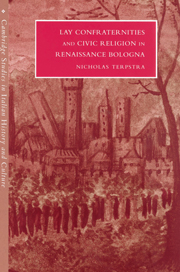Book contents
- Frontmatter
- Contents
- List of figures
- List of tables
- Acknowledgments
- Preface
- Prologue
- 1 The early quattrocento: confraternities, observance movements, and the civic cult
- 2 Lay spirituality and confraternal worship
- 3 The mechanics of membership
- 4 Communal identity, administration, and finances
- 5 Confraternal charity and the civic cult in the late fifteenth and early sixteenth centuries
- Epilogue
- Bibliography
- Index
3 - The mechanics of membership
Published online by Cambridge University Press: 24 September 2009
- Frontmatter
- Contents
- List of figures
- List of tables
- Acknowledgments
- Preface
- Prologue
- 1 The early quattrocento: confraternities, observance movements, and the civic cult
- 2 Lay spirituality and confraternal worship
- 3 The mechanics of membership
- 4 Communal identity, administration, and finances
- 5 Confraternal charity and the civic cult in the late fifteenth and early sixteenth centuries
- Epilogue
- Bibliography
- Index
Summary
Questions regarding the source and significance of confraternal piety would be virtually meaningless if the spiritual companies were marginal groups attracting a handful of members. In fact, the Bolognese confraternities, like their counterparts across Europe, attracted from ten to twenty percent of the adult population through the fifteenth and sixteenth centuries. At the beginning of this period, they drew men and women from a broad cross-section of Bolognese society; towards the end social and gender distinctions restricted access and led to new forms of confraternal association.
Statute provisions and membership statistics demonstrate again the self-regulating congregational nature of the spiritual companies, and underscore how they could function as lay alternatives to both the local parish and the monastery. We look first at the ceremonies surrounding the novitiate and profession to full membership, setting these against statistics showing how many novices of one company subsequently became professing members. The question of which confraternity an individual might approach is set in the context of the social geography of groups and the social standing of their members. Statistics on confraternal size, growth, and attendance indicate how many Bolognese claimed confraternal membership and how diligently they attended to the duties of membership. The processes and statistics of expulsions allow us to assess collective reaction to the less diligent, while statistics for members remaining until death indicate individual reaction to the collectivity.
- Type
- Chapter
- Information
- Publisher: Cambridge University PressPrint publication year: 1995



